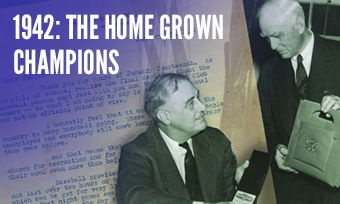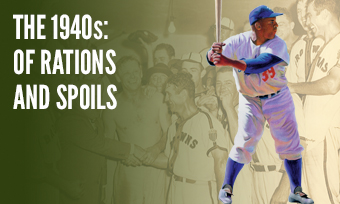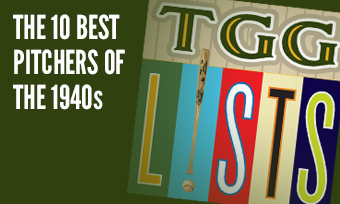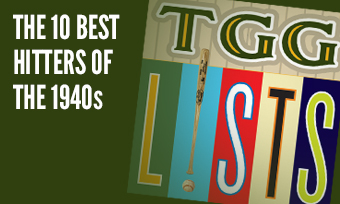The Yearly Reader
Leaders and Honors, 1942
Our list of baseball’s top 10 hitters and pitchers in both the American League and National League for the 1942 baseball season, as well as the awards and honors given to the game’s top achievers of the year.
The National League’s Top 10 Hitters, 1942
Bold type in brick red indicates league leader.
1. Enos Slaughter, St. Louis
Key Numbers: .318 average, 100 runs, 188 hits, 31 doubles, 17 triples, 13 home runs, 98 RBIs, 88 walks.
The tireless Slaughter, best remembered as a gritty second banana to Cardinals stars Johnny Mize and Stan Musial, was second to nobody in the NL in 1942.
2. Mel Ott, New York
Key Numbers: .295 average, 118 runs, 30 home runs, 93 RBIs, 109 walks.
The veteran Giants slugger was given rare and long-sought slugging protection from Johnny Mize, allowing him to extend his streak of seasons leading the team in homers to 14. (He’d stretch that mark to 18.)
3. Johnny Mize, New York
Key Numbers: .305 average, 97 runs, 25 doubles, 7 triples, 26 home runs, 110 RBIs, .521 slugging percentage.
The Big Cat was the only NL player with a slugging percentage over .500; the last time that happened was in 1920 (Rogers Hornsby).
4. Stan Musial, St. Louis
Key Numbers: .315 average, 87 runs, 32 doubles, 10 triples, 10 home runs, 72 RBIs.
The Man’s first full year at the plate pretty much put an end to the thought that he’d someday be a great pitcher—which is what the Cardinals originally brought him into the organization as.
5. Dolph Camilli, Brooklyn
Key Numbers: .252 average, 89 runs, 23 doubles, 7 triples, 26 home runs, 109 RBIs, 97 walks, 22 intentional walks, 10 stolen bases.
For the last of eight straight years, Camilli—one of the more reliable and underrated players of his time—hit at least 23 home runs. In 1943, at age 36, he would refuse a midseason trade to the Giants and escaped to a life of sunset baseball in the Pacific Coast League.
6. Bill Nicholson, Chicago
Key Numbers: .294 average, 83 runs, 173 hits, 22 doubles, 11 triples, 21 home runs, 78 RBIs, 76 walks, 8 hit-by-pitches.
Swish raised his batting average 40 points from a year earlier, but the Cubs would have appreciated had he hit as well against the NL’s top teams, St. Louis and Brooklyn (a combined .199) as he did against the other five (.331).
7. Pete Reiser, Brooklyn
Key Numbers: 125 games, .310 average, 89 runs, 33 doubles, 5 triples, 10 home runs, 64 RBIs, 20 stolen bases, 0 grounded into double plays.
A simple case of greatness lost, as Reiser’s star fell as hard as he ran into the Sportsman’s Park wall in mid-July to neuter what started as another MVP-worthy campaign.
8. Elbie Fletcher, Pittsburgh
Key Numbers: .289 average, 86 runs, 22 doubles, 5 triples, 7 home runs, 57 RBIs, 105 walks, .417 on-base percentage.
Fletch drew 100-plus walks for the third straight year, helping to lead the NL in on-base percentage—also for the third straight season.
9. Stan Hack, Chicago
Key Numbers: .300 average, 91 runs, 166 hits, 36 doubles, 3 triples, 94 walks.
A slight yet hardly alarming downtick for Hack, despite collecting two of his four career five-hit games.
10. Bob Elliott, Pittsburgh
Key Numbers: .296 average, 26 doubles, 7 triples, 9 home runs, 89 RBIs.
The gradual ascension of Elliott, in his fourth year with the Bucs, continued unabated despite a switch from the outfield to third where he would lead the NL in errors at that position over each of the next three seasons.
The American League’s Top 10 Hitters, 1942
1. Ted Williams, Boston
Key Numbers: .356 average, 141 runs, 186 hits, 34 doubles, 5 triples, 36 home runs, 137 RBIs, 145 walks, .499 on-base percentage, .648 slugging percentage.
With his first of two career triple crowns, Williams was undeniably second to none in the AL, except in the minds of MVP voters—who found their excuse in Joe Gordon.
2. Charlie Keller, New York
Key Numbers: .292 average, 106 runs, 24 doubles, 9 triples. 26 home runs, 108 RBIs, 114 walks, 14 stolen bases.
Nicknamed King Kong despite a slight height more worthy of Fay Wray, Keller drove opponents ape by reaching 100 in runs, RBIs and walks for the third straight year.
3. Joe DiMaggio, New York
Key Numbers: .305 average, 123 runs, 186 hits, 29 doubles, 13 triples, 21 home runs, 114 RBIs, 68 walks.
The more potent, ‘pre-war’ chapter of DiMaggio’s baseball career came to a close as he signed on with the Army having batted .339 with a seasonal average of 31 homers and 133 RBIs through his first seven years.
4. Joe Gordon, New York
Key Numbers: .322 average, 88 runs, 173 hits, 29 doubles, 4 triples, 18 home runs, 103 RBIs, 79 walks, 12 stolen bases, 95 strikeouts, 22 grounded into double plays.
The fifth-year second baseman clearly didn’t win the AL MVP because of the numbers—especially given he led the circuit in striking out, errors and grounding into double plays.
5. Chet Laabs, St. Louis
Key Numbers: .275 average, 90 runs, 21 doubles, 7 triples, 27 home runs, 99 RBIs, 88 walks.
A home run spree in which he belted seven over an eight-game stretch in mid-July helped bump his power numbers out of the annual 10-to-15 range more typical of him.
6. Wally Judnich, St. Louis
Key Numbers: 132 games, .313 average, 78 runs, 22 doubles, 6 triples, 17 home runs, 82 RBIs, 74 walks.
The young San Francisco native thrived down the stretch with a .365 average and nine homers over the season’s final two months—which made it all the more upsetting to Browns fans that he missed the next three seasons due to military service. (But then again, had it not been for World War II, the Browns might have moved to Los Angeles.)
7. Stan Spence, Washington
Key Numbers: .323 average, 94 runs, 203 hits, 27 doubles, 15 triples, 4 home runs, 79 RBIs, 62 walks.
Despite what you might think, Spence hit most (nine) of his AL-leading 15 triples on the road, not at ultra-spacious Griffith Stadium.
8. Johnny Pesky, Boston
Key Numbers: .331 average, 105 runs, 205 hits, 29 doubles, 9 triples, 12 stolen bases, 22 sacrifice hits.
The rookie shortstop sensation convinced Joe Cronin that he could sit down and manage full-time—but the war would force Pesky to wait four years to provide an encore.
9. George Case, Washington
Key Numbers: 125 games, .320 average, 101 runs, 164 hits, 26 doubles, 44 stolen bases, 6 caught stealing.
The pre-eminent basestealer of his day was successful 88% of the time in 1942, a remarkably high percentage for the day and age.
10. Dom DiMaggio, Boston
Key Numbers: .286 average, 110 runs, 178 hits, 36 doubles, 8 triples, 14 home runs, 48 RBIs, 70 walks, 16 stolen bases.
In his third year at the major league level, DiMaggio proved to be a worthy baseball sibling to star brother Joe, even as he tried enlisting in the Navy during the season (he was initially denied due to eyesight issues, but ultimately accepted after the season).
The National League’s Top 10 Pitchers, 1942
1. Mort Cooper, St. Louis
Key Numbers: 1.78 ERA, 22 wins, 7 losses, 10 shutouts, .759 win percentage, 37 appearances, 35 starts, 278.2 innings, .204 batting average against.
Cooper was nothing more than an average, competent starter until he traded in his screwball for a forkball; he obviously got the better end of the deal.
2. Johnny Beazley, St. Louis
Key Numbers: 2.13 ERA, 21 wins, 6 losses, .778 win percentage, 43 appearances, 23 starts, 215.1 innings.
The war made Beazley a one-year wonder; he hurt his arm in the service and never came close to paralleling his 1942 numbers.
3. Ray Starr, Cincinnati
Key Numbers: 2.67 ERA, 15 wins, 13 losses, 37 appearances, 33 starts, 276.2 innings, 106 walks.
The second year back for 36-year-old Starr after an eight-year absence in the bigs made for his finest time.
4. Johnny Vander Meer, Cincinnati
Key Numbers: 2.43 ERA, 18 wins, 12 losses, 33 starts, 244 innings, 102 walks, 186 strikeouts, .208 opposing batting average.
The fastball artist clamped down on his lack of control (for now), striking out fewer batters but walking fewer as well, while hitters hit for their worst collective average against him over his 13-year career.
5. Larry French, Brooklyn
Key Numbers: 1.83 ERA, 15 wins, 4 losses, .789 win percentage, 38 appearances, 14 starts, 147.2 innings, 36 walks.
Using a knuckleball he developed in the spring, the 35-year-old French had an incredible start in which he was 10-0 with a 0.69 ERA through mid-July before wilting; it would be his last major league campaign as he applied for the Navy after the season.
6. Whit Wyatt, Brooklyn
Key Numbers: 2.73 ERA, 19 wins, 7 losses, .731 win percentage, 217.1 innings.
Wyatt followed up his sterling 1941 effort with a worthy encore.
7. Claude Passeau, Chicago
Key Numbers: 2.68 ERA, 19 wins, 14 losses, 34 starts, 24 complete games, 278.1 innings, 25 grounded into double plays.
Passeau lost a shot at a second career 20-win season when he was outdueled by the Cardinals’ Johnny Beazley in his final start of the year.
8. Max Lanier, St. Louis
Key Numbers: 2.96 ERA, 13 wins, 8 losses, 34 appearances, 20 starts, 161 innings.
The evolving star pitcher was always a thorn for the Dodgers—and never more so than in 1942, when he won five games against Brooklyn to help the Cardinals storm to the pennant.
9. Bill Lohrman, St. Louis-New York
Key Numbers: 2.48 ERA, 14 wins, 5 losses, 31 appearances, 19 starts, 12 complete games, 170.2 innings.
After five years with the Giants, Lohrman was sent packing to the Cardinals in the trade that brought Johnny Mize to New York—but after failing to make waves in St. Louis, the Giants got him back.
10. Curt Davis, Brooklyn
Key Numbers: 2.34 ERA, 15 wins, 6 losses, .714 win percentage, 206 innings.
Like French, Davis continued a late-career revival with the Dodgers at age 39—but unlike French, stuck around through the war years, playing into 1946.
The American League’s Top 10 Pitchers, 1942
1. Tiny Bonham, New York
Key Numbers: 2.27 ERA, 21 wins, 5 losses, 22 complete games, 6 shutouts, .808 win percentage, 226 innings, 24 walks.
Ironically nicknamed Tiny in spite of a 6’2”, 200-pound frame, Bonham produced the AL’s first sub-1.00 WHIP (walks and hits allowed per inning) since Walter Johnson at the end of the Deadball Era in 1919.
2. Tex Hughson, Boston
Key Numbers: 2.59 ERA, 22 wins, 6 losses, .786 win percentage, 38 appearances, 30 starts, 22 complete games, 281 innings, 113 strikeouts.
Red Sox pitchers of recent years greatly benefited from the team’s generous offensive support, but Hughson’s second-year performance would have thrived even with low-rent hitting. His 113 Ks, tied with Bobo Newsom for the AL lead, was the lowest season total for a leader in league history.
3. Ted Lyons, Chicago
Key Numbers: 2.10 ERA, 14 wins, 6 losses, .700 win percentage, 20 starts, 20 complete games, 180.1 innings, 26 walks.
The well-preserved, 41-year-old knuckler, still pitching every Sunday on six days’ rest, completed every one of his 20 starts and won the only ERA crown of his 21-year career.
4. Spud Chandler, New York
Key Numbers: 2.38 ERA, 16 wins, 5 losses, .762 win percentage, 24 starts, 200.2 innings, 31 grounded into double plays.
The guy who seldom lost in a Yankees uniform (109-43 career mark) was par for the course.
5. Hank Borowy, New York
Key Numbers: 2.52 ERA, 15 wins, 4 losses, .789 win percentage.
The rookie right-hander’s excellent debut included a September 2 start that he thought was a no-hitter—until informed after the game that the official scorer had given a dubious hit on a play many thought Yankees second baseman Joe Gordon had erred on.
6. Jim Bagby Jr., Cleveland
Key Numbers: 2.96 ERA, 17 wins, 9 losses, 38 appearances, 35 starts, 270.2 innings.
In his fourth of 10 major league years, Bagby came as close as he ever would to the 31 games won by his father in 1920.
7. Hal Newhouser, Detroit
Key Numbers: 2.45 ERA, 8 wins, 14 losses, 5 saves, 38 appearances, 23 starts, 183.2 innings, 114 walks.
Rejected by the military due to a heart murmur, the 21-year-old Newhouser re-focused on baseball and halved his ERA from the year before—but also suffered from career-low run support that led to an unattractive record. The wins—lots of them—would come soon enough.
8. Red Ruffing, New York
Key Numbers: 3.21 ERA, 14 wins, 7 losses, 24 starts, 193.2 innings.
At age 37, Ruffing posted his ninth straight winning record—adding up to a 161-80 record during that stretch—before taking on pitching duty with the Army Air Transport Command team.
9. Marv Breuer, New York
Key Numbers: 3.07 ERA, 8 wins 9 losses, 27 appearances, 19 starts, 164.1 innings.
A spot starter in his fourth year with the Yankees, Breuer was used extensively (and effectively) down the stretch for the AL champs. He would be called to the war effort early the following year, never to return to baseball; instead, he would embark on a long career as a civil engineer.
10. Virgil Trucks, Detroit
Key Numbers: 2.74 ERA, 14 wins, 8 losses, 28 appearances, 20 starts, 167.2 innings.
After a tough start that led to a threat of demotion, the 25-year-old rookie snapped into it and pitched more like the guy who would grace the mound through the late 1950s.









